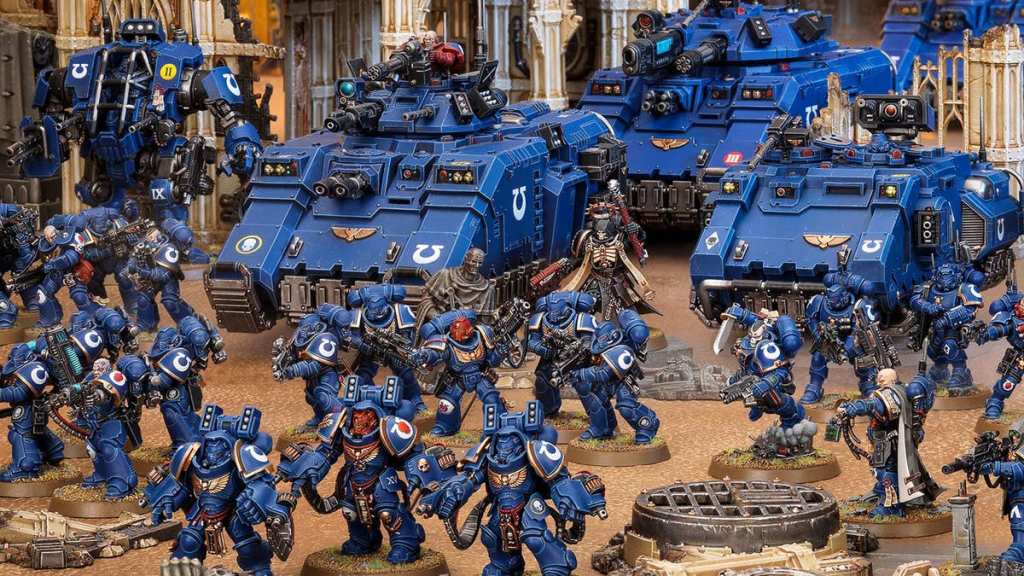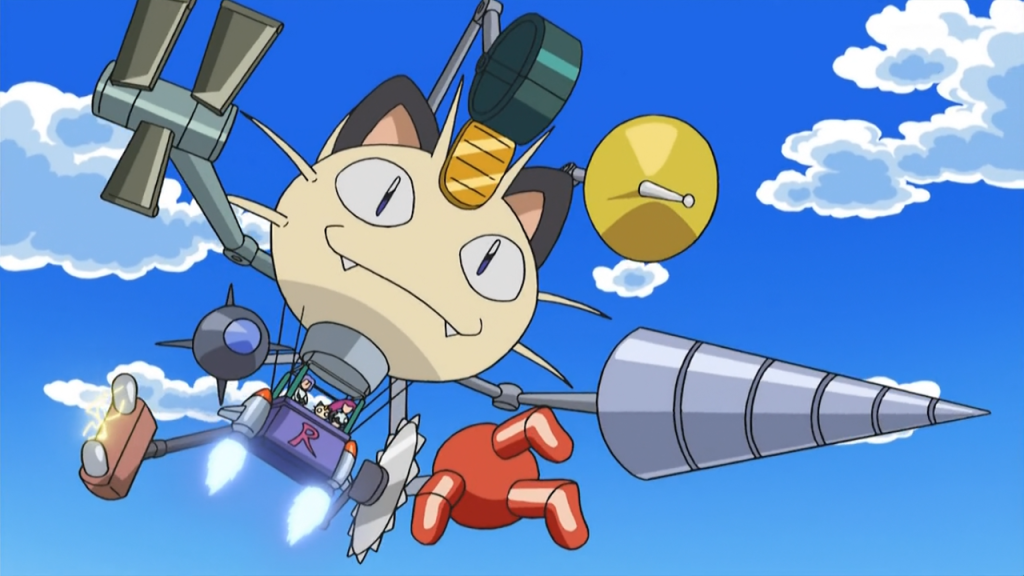What makes a series Mecha in genre is something that seems to be contested within fan circles from time to time, with people who are discussing often ending in general agreement with differences here and there. To some, having powered armours in your work is enough to move it from general science fiction to Mecha. Other might see giant robots in show just fine, but call with other terms because the mechanics aren’t in the spotlight.
What I’ve seen to be the most agreed upon qualification is If it has giant robots, then its Mecha. Everything else down the stream is a matter of contest and personal opinion.
All this is natural though, as Mecha as a genre is not exactly the most defined one. The clearest examples are overt with their nature, pushing the mechanical characters of the work to the forefront of the story, while some use them as if they’re a side dish complementing the main point of the story.
Looking at definitions online it seems that the first defining element is to have a giant humanoid robot is the first step. Being a vehicle doesn’t qualify. Of course, the term is a loanword of a loanword, taking how Japanese media has described everything from guns and computers to cars and giant excavation machines. Thus, the use of the term is different and shouldn’t be directly equated between regions.

This is why you more often saw the use of Robot animation, comics and games in Japan when referring to titles that would be referred as mecha in the Western world by the fans. The term has slipped into mainstream as well. There is also a mindset that Mecha refers only Japanese products, where the giant robots in .e.g. BattleTech aren’t mechas, but mechs. I don’t contest this, this is a meaningless flavor point, but I do understand the point of having the stereotypic image of Japanese robots being only kinds of Gurren Lagann or Gundam. This distinction is meaningless though, and is more often than not used to boost egos. They’re all giant robots in the end of the day.
I’ll drop my own coin in the game, and would argue that because of the undefined nature of the genre, we need to accept fuzziness in the genre’s boundaries. I would also ditch super robot and real robot distinction, as they’re largely bullshit terms for marketing outside Super Robot Wars.
Though first I’ll argue that Mecha genre is a descendant of Giant Robot. While we’ve always had some sort of constructs under human control in fiction, sometimes under human control, giant robot arguably, descents from the giant monster and giant hero boom that took over Japan prior to 1970s. (Giant) robot anime is a natural growth and exploration of both genres, but where rather than a monster or a transforming giant hero fighting for mankind, the hero is in a machine doing the fighting himself. Naturally, as children was the target audience, it’s easy to see a child putting himself into the position of the pilot. I’m making a distinction between just Robot Anime and Giant Robot Anime, thought the former is the classical term.
While Mazinger Z in 1972 is often cited as the grandpa of Mecha anime, Go Nagai himself has argued that he simply added to an existing genre. Tetsujin #28 from 1956 is often mentioned as a major predecessor, but we should also remember Mazinger Z had a contemporary with Astronganger, which aired two months earlier.
The 1970s was the golden era of Japanese animation, when the medium saw rapid expansion and exploration of genres and themes. Most of the shows followed the usual template set by Mazinger Z and its predecessors, while changing the formula to build something unique on top. Everything modern Mecha is stems from this era. Anyone who advertises a robot anime or mecha by saying that show is unique due to concentrating on characters rather than the robots hasn’t exactly watched any of the shows from this decade. There is no Mecha that isn’t about the characters. Are these people somehow missing how the robots themselves are designed to be characters as well?
Giant Robot as a genre was formed with the popularity of Mazinger Z, I’d argue. This gives a nice popular start point, but we can extend this to its predecessors too. I don’t think there’s a need to make a difference whether or not the robot is piloted and remote controlled, but piloted robots is a major reason why the genre exploded with Mazinger Z. It’s a dream, a man’s romance.
Mecha on the other hand came to be in the 1980s when a new generation entered the industry, and the toy market for giant robots having seen a major decline. Robots started going from very small to bionic, and with the OVA boom starting in 1985, we suddenly started to see animated robots that weren’t driven by toy companies.
Toys and robot animation will always go hand in hand. While some robots, likes the ones found in Muv-Luv or Neon Genesis Evangelion, weren’t designed for toys, vast majority of the genre is toy sales driven. That could be said about anime in general, where cross-media projects always have a merchandise component to them. The Transformers, Voltron, Goldrake and other shows have been claimed to be advertisement for toys, and that’s probably valid argument due to the sponsors’ connections. However, that often ignores the quality of the show itself. Some aimed to take concepts and characters further, with Toei’s Robot Romance Trilogy, consisting of Super Electromagnetic Robot Combattler V, Super Electromagnetic Machine Voltes V and Fighting General Daimos, being an example where the production team wanted to introduce more complex situations and interactions between characters. Voltes V would be influential on its own in the Philippines, where the show was banned by president Ferdinand Marcos alongside other shows for being too harmful for children, but considering Voltes V has strong themes of rebellion and revolution, it’s not too farfetched to say Marcos wanted to curb stomp any of these notions. He did go after pinball machines and arcades as well, known places where youth would gather and exchange ideas.
Giant Robot as a genre is what reads on the box; the robots are giant and more often than not fight either other giant robots or monsters. Humanoid shape is more or less required. I consider this the classical form of Mecha, from which modern depictions stem from. Giant Robot has become the archetypical form of Mecha when it comes to pop-culture and is probably the most mainstream depiction.

Giant Robot itself doesn’t require the robot to me pilotable or even mechanical. The Transformers and the Brave series both have extensive use of fully sentient robots that don’t require a human pilot. Both shows are a variation on the traditional Giant Robot with their own unique twist. The Transformers is probably the most well-known, if not the most popular, Giant Robot series in the United States and colours how the mainstream audience sees Mecha in general. Hence a need to have it as the umbrella term and whatever you want as sub-genres.
I’d wager this is the reason why genre variations make people question if something is Mecha or story that has robots in it. Is Neon Genesis Evangelion Mecha? is a question that pops up frequently. It’s a valid question. The show itself intentionally obtuse with its world building and overall story, which leads viewers grasping unto things they know. Especially in the Western world, the show’s Christian and Jewish imagery is something people grasp unto even if they’re intended to sound cool and exotic to its native audience. The whole psychological aspect of the show also stemmed from popularity of the topic at the time, and the show was intended to have imperfect characters that were closer to the viewer. Instead of hero characters from numerous previous shows, Evangelion’s characterization would stem from Mobile Suit Gundam and other shows that had main characters hesitant to take up to the role of piloting a giant war machine. The robots, the Evanglion units, were described as robots with helmets and gloves in Proposal sent to sponsors and stations for consideration.
Neon Genesis Evangelion is a sort of ultimate otaku anime. If you’ve only been exposed to Giant Robot in the Mecha genre, Evangelion comes across as weird, as if it were breaking genre the genre. However, just as much Evangelion is based on popular and exotic things of the era, so it is based on Hideaki Anno’s love for animation, comics and live action shows like Devilman, Mobile Suit Gundam, the Ultraman series and Gerry Anderson’s UFO.
However, it still possible to see how all that history amalgamates in Evangelion. Rather than taking at the series at face value, the intention of the series is to depict the Evangelion units as the last line of defense against an alien menace; giant biomechanical pilotable robots. The show can only be called deconstruction if the viewer isn’t aware of the author’s intentions, or worse yet, haven’t much else in the genre.
Unlike with Giant Robot, I can’t argue that Mecha as a genre has a defining starting point. It started with Mobile Suit Gundam, where fans would often argue that the robots in the show weren’t robots, but Mobile Suits as per series’ in-universe terminology. With the compilation movies, anime in general would step into larger mainstream and some would begin to treat the medium seriously on par with literature and films. Super Dimensional Fortress Macross follows the path laid out by Gundam, which lead the animation and toy industry exploring grass-level war stories with giant robots, sometimes with an emphasize on realism. The boiling point ended up producing shows and comics that don’t fit the traditional heroic Giant Robot genre, or in ways with each other, thus the birth of umbrella genre Mecha.
However, as said, there are no real hard rules what makes Mecha. If Neon Genesis Evangelion is a contested issue, series like Medarot seem to follow close behind. Medarot, at its core, is about collecting child-sized robots and battling them. It’s very much Pokémon with robots. This does not fit the whole giant robot image. However, it is innate to what I’d argue is essential to Mecha; exploring robots in wide forms and settings and their relationship with the rest of the cast. These robots are not necessarily humanoid or the main thing, but an essential element without which the story would either dramatically change or not work.

However, not all stories with robots are inherently Mecha in genre. Some genres have robots and other mechanical things as innate elements to their genre, like cyberpunk and other sub-genres of science fiction. Ghost in the Shell has robots, but they’re largely an extension when it comes to discussing larger themes of cyberpunk. Power Armours is contested as well, some claiming if their inclusion alone defines work Mecha. However, that’s shortsighted. It is necessary to look at the work as a whole. The two grand works of power armours, Starship Trooper and The Forever War have power armours at the forefront, but the works aren’t about the power armours. They are, first and foremost, military science fiction. In the broadest sense of Mecha we could include them simply because they exist in the stories.
This is an issue with the fuzziness of the term. Mecha in general had implied that the robotics is external or piloted. With time, he fuzzy region acceptance now covers a lot what the Japanese original mechanics holds, which ranges everything from guns to computer, cars to space stations. Accepting, or in some cases demanding it is used widely for anything that has mechanics, dilutes the definition from spicy special to bland beige. Series like Captain Harlock and Space Battleship Yamato are sometimes included in discussion what is Mecha, which are prime examples of shows that dilute the meaning of the term. I don’t consider their inclusion into Super Robot Wars as a valid argument, but do consider that argument as an example how diluted the term has ultimately become. One of definitions for both Giant Robot and Mecha was the necessity of humanoid robots that are separate from vehicles, and at least one of these shows is very much about a space ship vehicle.

By that extension we should put Space Knight Tekkaman Blade and Detonator Orgun on the podium and put the issue about power armours under the spotlight again. Similar to Starship Troopers and The Forever War, the series’ main gimmicks are stylish power armours. However, I’d argue that instead of Mecha, these two shows are examples of Transforming hero, the boys’ equivalent of magical girl shows. Instead of pretty clothes and magical tools to transform, both Tekkaman Blade and Orgun use technological equivalent, and instead of cute mascot characters you have mascot robots in case of Pegas in Tekkaman Blade. Both of these shows are in Super Robot Wars, though as with Battleship slot in XVT trilogy, this doesn’t define the shows’ genre itself. Similarly we could argue whether or not Fight!! Iczer-1 counts as Mecha, but I’d argue that it does as its one of the example of expanding exploration of the Giant Robot genre.
Admittedly, this post isn’t full of pin-point explanation on the nuances and differences within Giant Robot and Mecha genres, and that’s just because of the fuzzy nature of the latter. If you think about the genres otherwise, or disagree with my supposition about Giant Robot as a genre, that just shows the discussion is ongoing.
However, we can’t accept a narrow definition of Robot anime itself, because the nature of the genre has been expanded beyond its initial scope. This is also the reason why I dismiss Super Robot and Real Robot distinction, as there are clear examples of series that fit neither. Some have coined the term Hybrid, but that never caught any wind. Thus using existing terms, like Military Mecha, would describe numerous works more accurately. Most Gundam entries would fall into the aforementioned category, whereas Mazinger Z is the best example of classic Giant robot.
At the same time, we shouldn’t allow its variances, especially Mecha, to become like a widespread net that catches anything with mechanics. Robocop should not be considered Mecha despite having a cyborg main character and robots, as its main emphasis is on the cyberpunk elements within cop drama.

I should probably note that all Mecha is based on entertainment aimed at boys. This colours the expectations and how things are delivered. This is partially because Giant Robot Anime itself comes from media primarily aimed at boys. This is why the genre was deemed to have met a dead-end by the late 1970s, as you can replicate something only so long. Mobile Suit Gundam appealed to the female audience as well due to its “home drama” in the White Base. While not exactly the first show to have drama between characters, Gundam had exceptional presentation and focus for its time on drama for a Giant Robot Anime. Similarly, 1981’s Six God Combination God Mars had a strong female following, though for a bit more superficial reasons.
Giant Robot Anime is masculine and serves to cater to the men’s romance about machines. Arguably the genre also is a sort of knight’s tale, where men go to war. At least on its base. That’s how Mecha is largely seen as well by the general audience, as those are more or less the most common type of story Mecha has, at least on the surface. It’s easy to start wondering if something is Mecha when its story has a different base in the world building, like a character that doesn’t want to become pilot due to personal issues, or the shining armour turns out to be life-eating monstrosity. Nothing prevents Robot Anime or Mecha in general from being about sweet romance or mind-boggling horror. Psychological drama has become a stepping stone in the genres, but how many people will spend that extra time watching, or even reading up on the past shows?
Much like with many other things like this, I don’t find it necessary to overthink if something is X. However, at the same time slapping Mecha on everything that even has a passing bit of mechanics or robots in the show is diluting the term.






